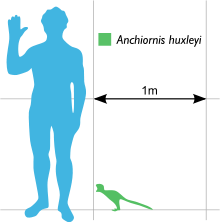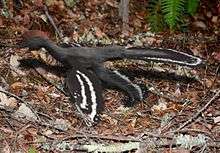Anchiornis
| Anchiornis Temporal range: Late Jurassic, 160.89–160.25 Ma | |
|---|---|
 | |
| Life restoration | |
| Scientific classification | |
| Kingdom: | Animalia |
| Phylum: | Chordata |
| Class: | Reptilia |
| Clade: | Dinosauria |
| Order: | Saurischia |
| Suborder: | Theropoda |
| Clade: | Avialae |
| Genus: | †Anchiornis Xu et al., 2009 |
| Species: | †A. huxleyi |
| Binomial name | |
| Anchiornis huxleyi Xu et al., 2009 | |
Anchiornis is a genus of small, feathered, eumaniraptoran dinosaurs. The genus Anchiornis contains only the type species Anchiornis huxleyi. It was named in honor of Thomas Henry Huxley, an early proponent of biological evolution, and one of the first to propose a close evolutionary relationship between birds and dinosaurs. The generic name Anchiornis means "near bird", and its describers cited it as important in filling a gap in the transition between the body plans of birds and dinosaurs.[1]
Anchiornis huxleyi fossils have been found in the Tiaojishan Formation of Liaoning, China, in rocks dated to the late Jurassic period (Oxfordian age), 160.89-160.25 million years ago.[2][3] [4]
Given the exquisite preservation of one of the animal's fossils, Anchiornis huxleyi became the first dinosaur species for which almost the entire life coloration could be determined.[5]
Description

Anchiornis huxleyi was a small, paravian dinosaur with a triangular skull bearing several details in common with dromaeosaurids and troodontids. Anchiornis had very long legs, usually an indication that they were strong runners. However, the extensive leg feathers indicate that this may be a vestigial trait, as running animals tend to have reduced, not increased, hair or feathers on their legs.[2] The forelimbs of Anchiornis were also very long, similar to archaeopterygids.
The first fossil was recovered from the Yaolugou locality, Jianchang County, western Liaoning, China; the second, at the Daxishan locality of the same area. The deposits are lake sediment, and are of uncertain age. Radiological measurements indicate an early Late Jurassic age for them, between 160.89 and 160.25 million years ago.[2][4]
Its size was originally estimated at 34 centimetres (13 in) and 0.11 kilograms (0.24 lb), but it could be in fact somewhat larger at 40 centimetres (16 in) and 0.25 kilograms (0.55 lb).[6]
Feathers

While the first specimen of Anchiornis preserved only faint traces of feathers around the preserved portion of the body, the well-preserved second specimen showed nearly complete feather preservation, allowing researchers to identify the structure of the feathers and how they were distributed.
As in other early paravians such as Microraptor, Anchiornis had large wings, made up of pennaceous flight feathers attached to the arm and hand (as in modern birds) as well as flight feathers on the hindlegs, forming an arrangement of forewings and hindwings. The forewing of Anchiornis was composed of 11 primary feathers and 10 secondary feathers. Unlike Microraptor, the primary feathers in Anchiornis were about as long as the secondaries and formed a more rounded wing, with curved but symmetrical central vanes, a small and thin relative size, and rounded tips, all indicating poorer aerodynamic ability compared to its later relative. In Microraptor and Archaeopteryx, the longest forewing feathers were closest to the tip of the wing, making the wings appear long, narrow, and pointed. However, in Anchiornis, the longest wing feathers anchored near the wrist, making the wing broadest in the middle and tapering near the tip for a more rounded, less flight-adapted profile.[2]
The hindwings of Anchiornis were also shorter than those of Microraptor, and were made up of 12–13 flight feathers anchored to the tibia (lower leg) and 10–11 to the metatarsus (upper foot). Also unlike Microraptor, the hindwing feathers were longest closer to the body, with the foot feathers being short and directed downward, almost perpendicular to the foot bones.[2]
Unlike any other known Mesozoic dinosaur, the feet of Anchiornis (except for the claws) were completely covered in feathers (much shorter than the ones making up the hindwing).[2]
Two types of simpler, downy (plumaceous) feathers covered the rest of the body, as in Sinornithosaurus. Long downy feathers covered almost the entire head and neck, torso, upper legs, and the first half of the tail. The rest of the tail bore pennaceous tail feathers (rectrices).[2]
Color

In 2010, a team of scientists examined numerous points among the feathers of an extremely well preserved Anchiornis specimen to survey the distribution of melanosomes, the pigment cells that give feathers their color. By studying the types of melanosomes and comparing them with those of modern birds, the scientists were able to map the specific colors and patterning present on Anchiornis when it was alive. Though this technique had been used and described for isolated bird feathers and portions of other dinosaurs (such as the tail of Sinosauropteryx), Anchiornis became the first Mesozoic dinosaur for which almost the entire life coloration was known (note that the tail of this specimen was not preserved).[5]
Most of the body feathers of Anchiornis were gray and black. The crown of head feathers was mainly rufous with a gray base and front, and the face had rufous speckles among predominantly black head feathers. The forewing and hindwing feathers were white with black tips. The coverts (shorter feathers covering the bases of the long wing feathers) were gray, contrasting the mainly white main wings. The larger coverts of the wing were also white with gray or black tips, forming rows of darker dots along mid-wing. These took the form of dark stripes or even rows of dots on the outer wing (primary feather coverts) but a more uneven array of speckles on the inner wing (secondary coverts). The shanks of the legs were gray other than the long hindwing feathers, and the feet and toes were black.[5]
Paleobiology

Anchiornis is notable for its proportionally long forelimbs, which measured 80% of the total length of the hindlimbs. This is similar to the condition in early avians such as Archaeopteryx, and the authors pointed out that long forelimbs are necessary for flight. Anchiornis also had a more avian wrist than other non-avialan theropods. The authors initially speculated that it would have been possible for Anchiornis to fly or glide. However, further finds showed that the wings of Anchiornis, while well-developed, were short when compared to later species like Microraptor, with relatively short primary feathers that had rounded, symmetrical tips, unlike the pointed, aerodynamically proportioned feathers of Microraptor.[2]
Anchiornis has hindleg proportions more like those of lower theropod dinosaurs than avialans, with long legs indicating a fast-running lifestyle. However, while long legs normally indicate a fast runner, the legs and even feet and toes of Anchiornis were covered in feathers, including long flight feathers on the legs, similar to those in the hindwings of Microraptor.[2] Long leg feathers on lower legs may have slowed the running speed of Anchiornis. In modern birds, especially those that live on the ground, the lower legs tend to show reduction or even loss of feathers.[2] The skeletal structure of Anchiornis is similar to Eosinopteryx, which appears to have been a capable runner due to its uncurved rear claws and absence of flight feathers on its tail or lower legs. Anchiornis shared a similar body plan and the same ecosystem as Eosinopteryx, suggesting different niches and a complex picture for the origin of flight.[7][8]
Like many modern birds, Anchiornis exhibited a complex pattern of coloration with different colors in speckled patterns across the body and wings, or "within- and among-feather plumage coloration." In modern birds, such color patterning is used in communication and display, either to members of the same species (e.g. for mating or territorial threat display) or to threaten and warn off competing or predatory species.[5]
History of discovery

The type specimen (in the collection of the Institute of Vertebrate Paleontology and Paleoanthropology, specimen number IVPP V14378) was described by paleontologist Xu Xing and colleagues in a paper accepted to the Chinese Science Bulletin in 2009. Xu et al. assigned Anchiornis to the Avialae in this paper. The specimen consists of an articulated skeleton missing only the skull, part of the tail, and the right forelimb. The authors estimated that a complete individual would be 34 cm (13 in) and weigh only 110 g (3.9 oz).
A second specimen was reported on September 24, 2009, in the journal Nature. It is catalogued as number LPM – B00 169 in the Liaoning Paleontological Museum. It is larger and much more complete and preserves long wing feathers on the hands, arms, legs and feet, not unlike Microraptor. There is also a feathered crest on the head. This second specimen preserves more features, and led Hu and colleagues to reassign Anchiornis to the Troodontidae,[2] though more comprehensive studies would later suggest it was more closely related to Archaeopteryx as a basal member of Avialae.[9] A third specimen, preserving a nearly complete skeleton missing the tail and a partial skull, also with extensive feather preservation, was reported in 2010. This third specimen was used to determine the life coloration. It is housed in the Beijing Museum of Natural History with the specimen number BMNHC PH828.[5]
While only three specimens have been formally described, many more have been identified and are held in both private collections and museums. The Shandong Tianyu Museum of Nature in Pingyi County, China, for example, was reported to hold 255 specimens of Anchiornis in its collections in 2010.[10]
See also
References
- ↑ Xu, X.; Zhao, Q.; Norell, M.; Sullivan, C.; Hone, D.; Erickson, G.; Wang, X.; Han, F. & Guo, Y. (2009). "A new feathered maniraptoran dinosaur fossil that fills a morphological gap in avian origin". Chinese Science Bulletin. 54 (3): 430–435. doi:10.1007/s11434-009-0009-6.
- 1 2 3 4 5 6 7 8 9 10 11 Hu, D.; Hou, L.; Zhang, L. & Xu, X. (2009). "A pre-Archaeopteryx troodontid theropod from China with long feathers on the metatarsus". Nature. 461 (7264): 640–643. Bibcode:2009Natur.461..640H. doi:10.1038/nature08322. PMID 19794491.
- ↑ Liu, Y.-Q.; Kuang, H.-W.; Jiang, X.-J.; Peng, N.; Xu, H. & Sun, H.-Y. (2012). "Timing of the earliest known feathered dinosaurs and transitional pterosaurs older than the Jehol Biota". Palaeogeography, Palaeoclimatology, Palaeoecology. 323–325: 1–12. doi:10.1016/j.palaeo.2012.01.017.
- 1 2 Chu, Z.; He, H.; Ramezani, J.; Bowring, S.A.; Hu, D.; Zhang, L.; Zheng, S.; Wang, X.; Zhou, Z.; Deng, C.; Guo, J. (2016). "High-precision U-Pb geochronology of the Jurassic Yanliao Biota from Jianchang (western Liaoning Province, China): Age constraints on the rise of feathered dinosaurs and eutherian mammals". Geochemistry, Geophysics, Geosystems. doi:10.1002/2016GC006529.
- 1 2 3 4 5 Li, Q.; Gao, K.-Q.; Vinther, J.; Shawkey, M. D.; Clarke, J. A.; d'Alba, L.; Meng, Q.; Briggs, D. E. G. & Prum, R. O. (2010). "Plumage color patterns of an extinct dinosaur". Science. 327 (5971): 1369–1372. Bibcode:2010Sci...327.1369L. doi:10.1126/science.1186290. PMID 20133521.
- ↑ Paul, G.S., 2010, The Princeton Field Guide to Dinosaurs, Princeton University Press p. 128
- ↑ Godefroit, P.; Demuynck, H.; Dyke, G.; Hu, D.; Escuillié, F.; Claeys, P. (2012). "Reduced plumage and flight ability of a new Jurassic paravian theropod from China". Nature Communications. 4: 1394. Bibcode:2013NatCo...4E1394G. doi:10.1038/ncomms2389. PMID 23340434.
- ↑ Fraser, G. (2014). ""Bizarre structures" point to dromaeosaurs as parasites and a new theory for the origin of avian flight." (Automatic PDF download). Journal of Paleontological Sciences. 6: 1–27.
- ↑ Godefroit, P.; Cau, A.; Dong-Yu, H.; Escuillié, F.; Wenhao, W. & Dyke, G. (2013). "A Jurassic avialan dinosaur from China resolves the early phylogenetic history of birds". Nature. 498 (7454): 359–62. Bibcode:2013Natur.498..359G. doi:10.1038/nature12168. PMID 23719374.
- ↑ "China has world's largest dinosaur museum". Dawn. 4 August 2010. Archived from the original on 2010-10-28. Retrieved 2010-11-06.
External links
- Life restoration of Anchiornis huxleyi by paleoartist Julius T. Csotonyi
- Reconstructed image of Anchiornis huxleyi with full-body color patterns as described by Li et al., National Geographic